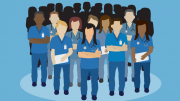The COVID-19 pandemic is a crisis like no other the world has seen in terms of its economic and social impacts. UNSDG Goal 1 is a bold commitment to end poverty in all forms and dimensions by 2030, but experts say that at the current rate we are progressing, it will be nearly impossible to achieve this in 10 years. As the virus continues to ravage the world, unsurprising statistics have shown that poor communities have not only become hot spots for COVID transmission, but that the pandemic could push about 49 million more people into extreme poverty in 2020, and millions upon millions more unemployed and financially unstable.
We have seen this trend in both the US and even small, developing nations. Stringent quarantine measures have brought economic activity to a halt, disrupting food supply and governments’ capacities to provide income support to affected families. Here’s how poverty and COVID-19 have been intersecting, and what YOU as an IMSA student can help.
- Those living in marginalized communities lack social and sanitary protection
Health care and preventative services are hectic to access even for middle-class families, let alone the socially-marginalized groups that lack these protective services on a day-to-day basis. This includes the homeless, immigrants, refugees, migrants, internally-displaced communities in any country, and those living in slums. Given the living and sanitary conditions in refugee camps and shelters, one can easily see just how rapidly COVID-19 can spread, and these communities are less likely to have the resources and outside support to fight off the virus.
- Lower wealth = lower health
The effects of disease outbreaks on poor, low-income communities are well-known; those who hold insecure jobs cannot afford to stay home when they are sick, enforcing lockdowns make it difficult for those living in small, confined spaces, and many of these communities simply have no access to basic necessities such as running water or soap. The responses that governments have been giving have not been poverty sensitive, and because of this, most cases in developing countries have been going under to undetected.
- Reproductive health care is more limited during crises
Contraception has shown itself to be one of the simplest yet most effective ways to reduce poverty especially in countries where child marriage is common and the number of children in families are relatively large. Modern contraception ensures that more young women stay in school and prevents the number of children that will grow up in poverty, and likely stay in poverty. However, without adequate resources and information about when and if to have a baby, women are more likely to have unplanned pregnancies. Unplanned pregnancies have also been linked to increased school dropout rates and lower-income earnings later in life.
- Job instability perpetuates poverty rates
Job instability leads to several negative consequences, but during a time where unemployment rates are skyrocketing and the need for new employees are dropping, those who are unable to work risk being unemployed for much longer than usual and may be pushed into the poverty line. In addition, they may also be subject to losing health care employment benefits. This job instability in combination with the widespread declining economic status only leads to more disease, which in turn leads to more poverty.
During times of limited travel and interaction constraints, the question comes down to what we, as students, can do to help during a time like this.
- First and foremost, do what you can to limit the spread. Practice social distancing to ensure that the efforts of those self-isolating aren’t going to waste when you go out to party with friends, wash your hands regularly, and follow CDC regulations.
- Donate to verified COVID-19 response funds. These funds go directly to nonprofits helping poor communities and help supply food and other necessities to those in need.
- Provide support and encouragement for struggling friends, neighbors, or community members. Whether it be small services such as grocery delivery or providing emotional support for somebody who was laid-off, showing that you care and doing what you can to help goes a long way.
The pandemic is still far from over, but COVID-19 offers everybody a moment in time to pay attention to the inequities and disparities in our communities. As the possibility of treatments and vaccines develop, it’s important to continue being aware of your circumstances and practicing social distancing.
Stay safe and stay healthy!






Be the first to comment on "How COVID-19 Has Impacted Our Fight Against Extreme Poverty"